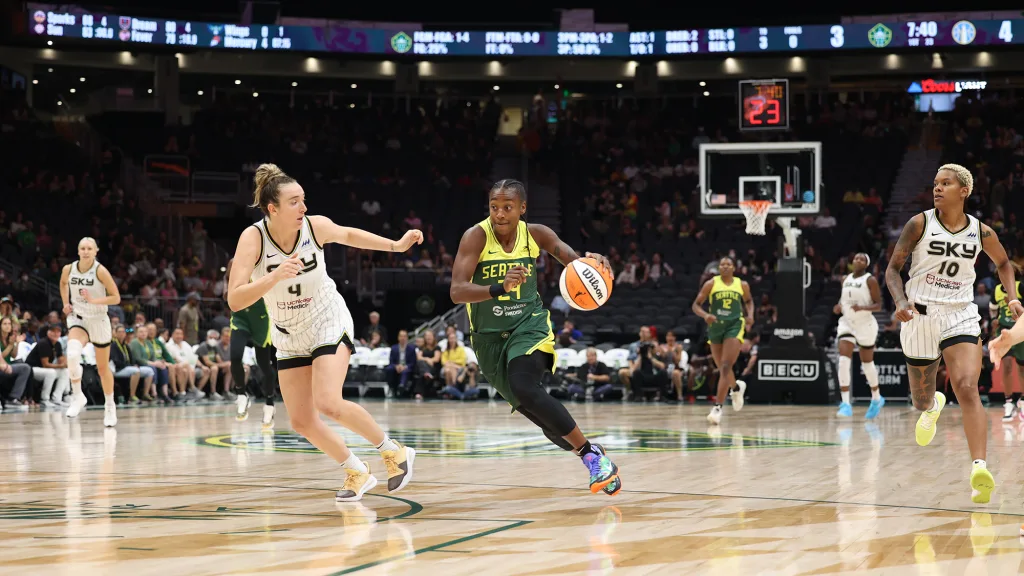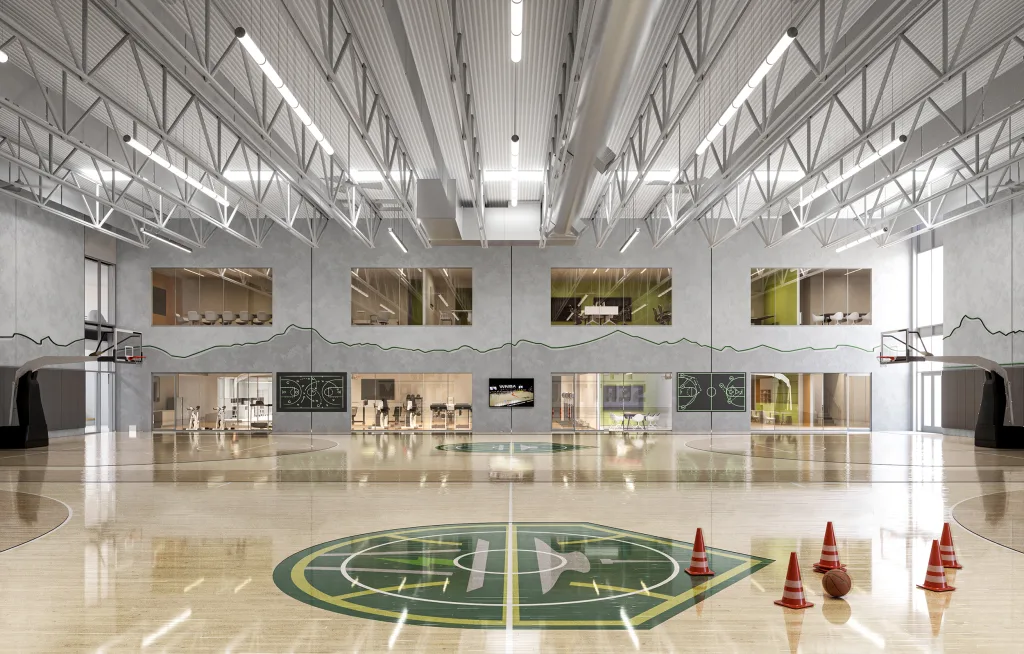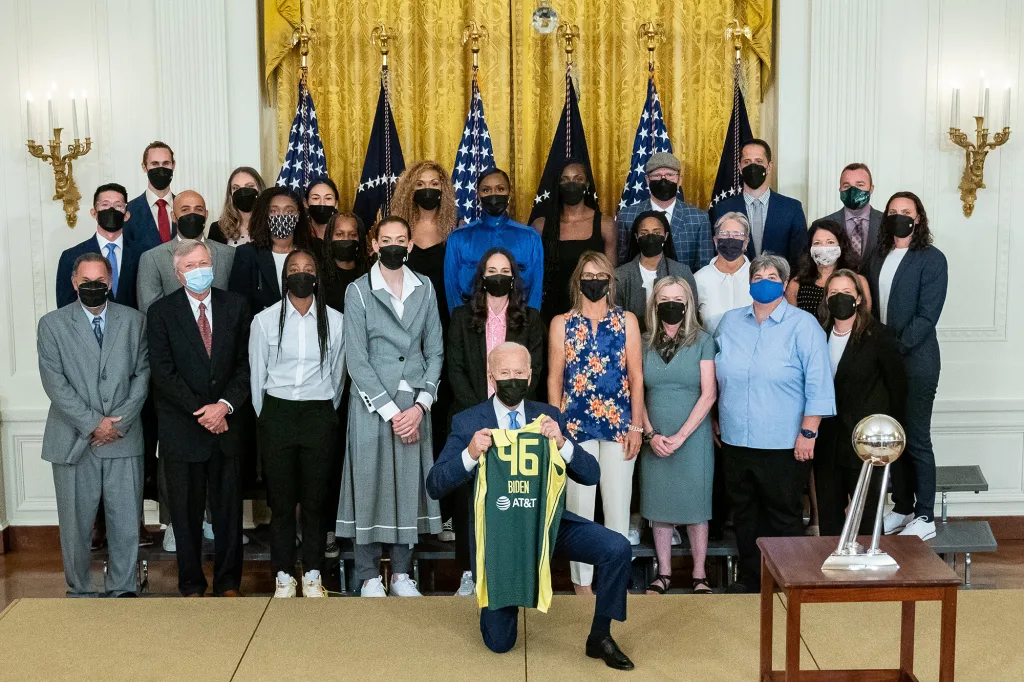A year after former Starbucks CEO Howard Schultz sold the Seattle SuperSonics to Sooner State mogul Clay Bennett, in 2006, the new owner made clear his plans to move the franchise to Oklahoma City.
Fans were devastated. But a handful of Seattle-based executives and civic leaders were more concerned about the Sonics’ WNBA sisters. The Seattle Storm, the Emerald City’s beloved women’s basketball team, had also been part of the sale.
Lisa Brummel, Ginny Gilder, Anne Levinson, and Dawn Trudeau were all former college athletes and Title IX warriors, battling discrimination at their universities to ensure equality for women’s sports. Levinson, a retired municipal court judge and former deputy mayor, had fought against the elimination of the women’s field hockey team at Kansas University in the 1970s. Brummel had been a four-sport athlete at Yale, and the women’s basketball’s MVP all four seasons. Gilder, a member of Yale’s class of 1979, had protested the lack of facilities for women rowers.
Gilder later became a private equity and real estate investor, and Brummel and Trudeau division heads at Microsoft. As experienced executives—and season ticket holders for the Storm—they knew the value of the team, and they were determined to keep it in Seattle.

The women, however, weren’t the kind of ultra-wealthy businesspeople who usually become sports magnates. Bennett and his partners had paid a reported $350 million for the Seattle teams. Fortunately, he was willing to part with the Storm for a mere $10 million. The women created an LLC, Force 10 Hoops, scraped together the down payment, and, in 2008, a deal was struck to keep the team in Seattle. (Levinson left Force 10 Hoops in 2010.)
In February 2023, after its owners sold a minority stake to help finance a new practice facility, the Storm announced it had a new valuation: a whopping $151 million—a jump of 15x in a league where teams continue to trade in the single- and low-double-digit millions. More significantly, it was the highest valuation of any women’s team, anywhere in the world, ever.
In 2019, the New York Liberty reportedly sold for between $10 to $14 million. Two years later, the Las Vegas Aces, the league champions in 2022, were reportedly bought for a mere $2 million. But those valuations, in women’s soccer as well as basketball, are now shooting up, thanks to the benchmark set by the Storm. Indeed, eight months after the Storm announcement, the sports business publication Sportico estimated the Angel City Football Club was worth even more, an astounding $180 million.
Also at work is an emerging recognition that—counter to decades of assumptions—women’s sports are actually good business. Take a look, for example, at the stratospheric viewership numbers—and ad dollars—during the women’s NCAA basketball tournament earlier this month. Last weekend’s final between South Carolina and Iowa notched a record-setting 18.7 million viewers. That’s more people than viewed any single MLB, NHL, or NBA game last year.
In the pro women’s league, the Chicago Sky was valued at $85 million last spring. And two years ago, the league as a whole was valued at more than $1 billion, as WNBA Commissioner (and former Deloitte CEO) Cathy Engelbert drives a plan to turn the organization into a financial powerhouse.
The same trend is taking place in other sports. The National Women’s Soccer League, in particular, is on a tear as teams set record prices. The Thorns were bought for $63 million in January, and the San Diego Wave went last month for $113 million.

The Storm’s owners were instrumental in laying some of the groundwork for this growth. They were among the first to understand—a decade ahead of most potential investors—that women’s sports can not only be profitable, but lucrative.
Sometimes innovation takes place when founders create something that’s never existed before. In other cases, as here, it takes place when leaders see the potential in a space that everyone else has written off. And once they dive in, they’re positioned to take advantage of new waves of opportunity created by ensuing shifts in the ecosystem.
“What the Storm did was create a role model for the long-term viability of these franchises,” Engelbert says.
And sometimes innovation happens when you have no choice. The women who bought the Storm couldn’t afford to absorb perpetual losses the way the owners of other women’s teams did. Their business savvy, however, told them they probably wouldn’t have to. The Seattle team was hugely popular. The fan base was there. Someone just needed to start making the business work—as a business.
“From the beginning, we had a very clear strategy,” says Gilder. “We were going to seek to make money.” Otherwise, she says, “the [WNBA] would remain a hobby, dependent on the largesse of people who thought, ‘This would be kind of cool, but who cares if we lose money?’”
That prescience has paid off. Today, the Storm are not only the most valuable team in the WNBA, they’re also one of its best businesses. The four-time champions had a disappointing season on the court last year after legendary point guard Sue Bird retired and star power forward Breanna Stewart moved to the New York Liberty. But the team leadership used their business smarts once again to take an unconventional path to rebuilding, choosing to spend their salary dollars on two seasoned free agents rather than newcomers in the league draft. As the team moves into its new practice facility this month—the first purpose-built space for a WNBA team—they will continue to be one of the most-watched teams in the league, both on and off the court.

Investors are beginning to see the potential in women’s sports, but that’s a new trend. Historically, these organizations have been viewed more as charity cases—ventures to be backed by wealthy individuals or groups out of a sincere interest in women’s athletics, or for the halo effect of supporting gender equity. Sometimes, teams have been owned by organizations with multiple sports interests, where the women’s team benefits from access to top-tier resources, but isn’t given the rigorous business focus of the larger enterprises.
Most WNBA teams, for example, either share an umbrella organization with their NBA siblings, like the Liberty (with the Brooklyn Nets) and the Minnesota Lynx (with the Minnesota Timberwolves). Or they’re owned by groups or individuals with other business interests. The Connecticut Sun, for example, are owned by the Mohegan Tribe, which operates casinos and resorts.
The Storm are one of only three truly independent teams in the league, and perhaps the only one without an enormous bank account. “When you can’t afford to lose money, it changes how you look at your business,” Gilder says. Indeed, the only outside investment the Storm’s owners have taken came last year, when they raised $21 from 12 investors to help build the new practice center.
From the beginning, the owners eschewed the approach many women’s teams have taken, of saving money by simply minimizing expenses. Growth, they believed, was the only path to financial viability.
Take the marketing and sales staff. Some teams only keep them on for the season. Brummel says that doesn’t work when your goal is to spin up revenue. These are the employees who know the fans best. The Storm figured out how to keep them on year-round by putting them to work in the off-season managing other organizations’ ticketing needs and devising new ideas for Storm ticket packages and merchandise. “Rather than save money, we decided to spend it,” Brummel says. “It was a massive accelerator.”
Meanwhile, the organization has focused on enhancing the fan experience, especially for families. They’ve sold ticket bundles with the local science museum, launched a kids’ halftime dance troupe, and created a special family section on weekends where, Brummel explains, “you’ll get a good view of the game, but you can also walk back five rows and run around the concourse.”
They’ve also refused to offer cut-rate tickets, as some teams do to keep stadiums full. “Once you start at $10, it’s really hard to grow,” Brummel says. The average Storm ticket today is $60, 27% higher than the league average of $47. “We believed women’s sports had value, and we expected people to pay for it,” Brummel says.
The team is now one of the league’s top earners. Its games consistently attract among the largest crowds. In 2022, they had the highest average attendance of any team—which was 25% more than the next highest in the league. And even last year, as they sunk to 11th place after the departures of Bird and Stewart, the Storm still drew the third-highest number of fans. Ticket revenue has grown 250% over the past decade, and money from sponsorships 570%. Even in last year’s disappointing season, the Storm’s regular-season ticket sales were still the highest of any team—and they generated double the revenue of the next highest-selling franchise.
A decade after the purchase, the Storm’s owners had accomplished what they set out to prove: “There’s a legit product here that can make you a legit business,” Brummel says, “if you put resources behind it.” Importantly, there’s no secret playbook here. While the Storm have been creative and resourceful, they didn’t figure out something other leadership teams couldn’t have. “We just applied good business principles to what we saw in our marketplace,” Brummel says.
Their success is beginning to wake others up. “We need to transform the economics of this league,” Engelbert says of the WNBA as a whole. With the Storm, she says, “it started with the business transformation.”
The money generated by women’s sports remains just a drop in the bucket compared to men’s. There’s a long road to parity. (The average NBA team, for example, is worth about $4 billion.) But turning the Storm into one of the best business operations in the WNBA positioned it to make the next leap forward: building a home of its own.

Gilder had long argued the Storm should have a practice facility. Women athletes—in all sports—are often vagabonds. While NBA teams have state-of-the-art practice centers, with multiple courts, weight rooms, hot and cold pools, medical staff, and team chefs, some women’s teams have to make do with space rented from local colleges. The hours are limited. Gear has to be lugged back and forth. And there’s no access to ancillary spaces, like rooms to watch game tape.
Brummel agreed a practice center would be transformative. “Players these days need to play and work out, year-round,” she says. Plus, putting everyone under the same roof has an exponential effect on team cohesion and efficacy.
But Brummel initially resisted pulling the trigger. Back in 2018, as the leaders bounced the idea around, the team was already dealing with upheaval caused by the multi-year closure of the KeyArena, their Seattle home, as it underwent a renovation into the ultramodern Climate Pledge Arena. The Storm had to relocate to a temporary home and hope their fans would follow.

Then, in 2020, the larger ecosystem shifted. The pandemic forced many sports to cancel or cut back their seasons. The NBA and WNBA forged ahead in isolation bubbles. But with space freed up on broadcast schedules, the women’s games got more airtime than ever before—and more viewers. Meanwhile, WNBA players stepped to the forefront of the Black Lives Matter movement as they spoke out on racial justice.
Suddenly, the WNBA was present in the national consciousness at a whole new level. When the Storm nailed the championship that October, the time was suddenly right. “We saw the market moving,” Gilder says. “So we decided to go big.”
Raising money in the following years for the $64 million Seattle Storm Center for Basketball Performance was an uphill battle. Skepticism remained around the economics of women’s sports, foreclosing the possibility of securing a real estate construction loan from a bank. So the team had to turn to private investors and trade equity for cash to fund construction. For that they needed to know how much the organization was worth. But even when they approached consulting firms about preparing a valuation, they got pushback. “We ran into everything, from being patted on the head, ‘Oh, you nice women, good for you,’” Brummel says, “to ‘We have no idea how to do this.’”
Sports valuations are based on comps, but there were no comps for a team like the Storm. The most recent WNBA trades were all distressed sales. CAA ICON, the vaunted sports management consulting firm that agreed to work with them, had to build a new framework for assessing a thriving women’s organization.
Part of a valuation is based on a franchise’s own performance. The Storm’s management rigor and financial strength created a foundation for a healthy price tag. But another part is based on the larger industry. In this case: Was women’s basketball likely to grow?
Historically, growth has been difficult. It’s hard to build fans and brands if no one sees you. The media has traditionally bypassed women’s sports. In the pre-digital era, space on television and in print was limited. The gatekeepers—producers and editors (mostly men)—couldn’t imagine people wanted to watch or hear about women players. “The NFL, the NBA, the NHL, and Major League Baseball used up all the airtime,” says Pete Giorgio, who heads Deloitte’s global and U.S. sports practices.
That’s now changing, with the explosion of new cable and streaming channels that are voracious for content. “We brought on Scripps’s ION as a broadcast partner” last year, says Engelbert, “and they brought us over five million incremental viewers.” Even more, ION committed to a habit-forming prime time slot. According to Nielsen, the “WNBA Friday Night Spotlight” grew the league’s total audience by 24%.
Now add in social media. Teams and players are building their own followings, independent of the attention bestowed by traditional media. And women, in particular, are particularly skilled at social media. “Women athletes often have a real talent for connecting with their audiences,” says Leela Srinivasan, CEO of Parity, a sports marketing agency that represents more than 1,000 women from a range of sports. “All that means that fans are more eager and more curious to tune into and show up at a game.”
Driving some of this is the emergence of a new kind of fan that the WNBA has dubbed “lifestyle viewers”: people who haven’t traditionally watched sports, but who follow individual women (the way the Michael Jordans or Kobe Bryants have historically drawn non-sports fans to the men’s game). Witness, for example, the 12 million viewers who tuned into the April 1 NCAA matchup between LSU’s Angel Reese (2.7 million Instagram followers) and Iowa’s Caitlin Clark, who’s so legendary even country singer Tim McGraw was wearing her #22 jersey at a recent concert. “The WNBA is not just a sport,” Engelbert says. “It’s culture.”
All of which is busting open legacy assumptions about fan preferences. Last year, the annual Seton Hall Sports Poll found that half of both men and women would like to see more women’s games. And research from pollster YouGov found that almost half of 18-24 year olds actually prefer to watch women’s sports over men’s.
Advertisers and sponsors are taking note, says Deloitte’s Giorgio. They’re clocking the “sharp increases in the number of people watching these events, and they want to associate with that.” Brands like Nike, Pepsi, Glossier, Mielle, and Google are now partnering with the WNBA, while teams and individual players have deals with L’Oreal, CarMax, Adidas, and Gatorade.
That could spell good news for WNBA coffers: The league is set to negotiate a new broadcast deal next year to replace its expiring agreement with ESPN. Last year, when the NWSL inked a four-year, $240 million agreement with Amazon, CBS, ESPN, and ION, it was 40 times larger than the one it had secured just three years before.
A new report from Deloitte predicts global revenue for all professional women’s sports will finally cross the $1 billion mark this year. In a sign of how rapidly the tide is turning, those estimates are 300% higher than the ones the firm put out just three years prior. “It all boils down to the visibility of women’s sports and the visibility of women athletes,” Giorgio says.
Srinivasan, who previously worked in tech, says she thinks this is just the beginning of a giant surge. “I think about the level of frenzy around social platforms when I joined LinkedIn in 2010. It almost felt like a gold rush,” she says. “I’m only nine months in with women’s sports, and I feel that same energy.”

All of these factors played into the valuation CAA ICON prepared for the Storm, which in turn, allowed it to raise that $21 million for the Storm Center without giving up more than a 14% stake. (Notably, when the owners looked for new investors, they purposely sought out individuals or groups with women, LGBTQ, or BIPOC partners. “We were very intentional,” Brummel says. “It was very important to us that anyone who came into the ownership group represented our values.”)
The two-story, 50,000 square-foot facility was completed this month, ahead of the May start of 2024 season. The gleaming structure has several courts, strength and conditioning rooms, hydrotherapy pools, a steam room, sauna, kitchen, dining areas, and lounges, as well as meeting rooms and offices for business staff. The walls are plastered with Storm green and yellow, and the team’s four championship trophies sit in prominent glass cases.
In February, two of the league’s most in-demand free agents decided to come on board. Eight-time All-Star Nneka Ogwumike said at a press conference she was so used to making do with whatever a team provided that a dedicated home hadn’t been on her list of priorities. But then she saw the Storm Center. “Being around people saying, ‘This is yours. This is what you deserve’—it was a feeling I hadn’t felt before,” Ogwumike said. The building “felt like a physical representation of my worth.”
While the Las Vegas Aces also have their own training center, they converted it out of an existing warehouse, rather than building it from scratch as the Storm did. The Chicago Sky, meanwhile, are scouring the Windy City for a location of their own. “It’s the next big step,” Brummel says. “Every team is going to need their own facility.”
These efforts are echoing through the NWSL. Both Angel City and a new Bay Area expansion team say they plan to build their own training centers. The Kansas City Current went a step further and built the first-ever stadium for any professional women’s team in the world. It opened last month with a match against the Portland Thorns.
Since valuations are a signal of a league’s economic potential, the Storm intentionally partnered with a respected firm to do theirs. Its impact, they knew, would ripple outwards. “We want this to be the floor,” Gilder told The Athletic when the Storm’s $151 million price tag was announced. She didn’t have to wait long. Angel City’s $180 million assessment came just months later. The average U.S. women’s soccer team is now worth $66 million.
In basketball, the Sky are the only other professional women’s team with a recent valuation. Last fall, however, the NBA’s Golden State Warriors reportedly paid a head-spinning $50 million to add an expansion team to the Bay Area. The last time a new franchise came on board was 15 years prior, when the Atlanta Dream put down just $10 million to join the league. “Women’s sports is taking off in a big way,” Warriors’ majority owner (and former Kleiner Perkins partner) Joe Lacob said when the San Francisco team was announced. “We are talking with sponsors, and they all want to be involved. That is different than it was 10 years ago.”
Indeed, serious investors are now sniffing around. The new Bay Area soccer team is being backed by a $70 billion private equity firm. A report from BDO and the Sports Consultancy identified women’s sports as a “blue ocean”—an undervalued space with meaningfully more growth potential than men’s organizations.
“Finally,” Gilder says, “something has shifted.”
There might be an additional factor driving this shift: the emergence of all-female leadership groups. The Storm owners, like the owners of the NWSL’s Boston Unity and Angel City, come from new generations of women who’ve risen, en masse, to the top of their fields. They’ve accumulated their own expertise, their own wealth, and their own networks. When they decided to change the game in women’s sports, they didn’t have to convince traditional power players. They just made it happen.
Gilder says back when she and her partners decided to buy the Storm, her father, a seasoned investor who founded the Gilder Gagnon Howe & Co. brokerage, was skeptical she’d ever see her money again. “He wasn’t being disparaging,” she says. “He was just laying it out.”
Gilder saw it differently. “We believed we could build something,” she says. “We believed that one day the culture would shift. And we believed in ourselves. And we always bet on ourselves.”
Recognize your brand’s excellence by applying to this year’s Brands That Matter Awards before the final deadline, June 7.
Sign up for Brands That Matter notifications here.
